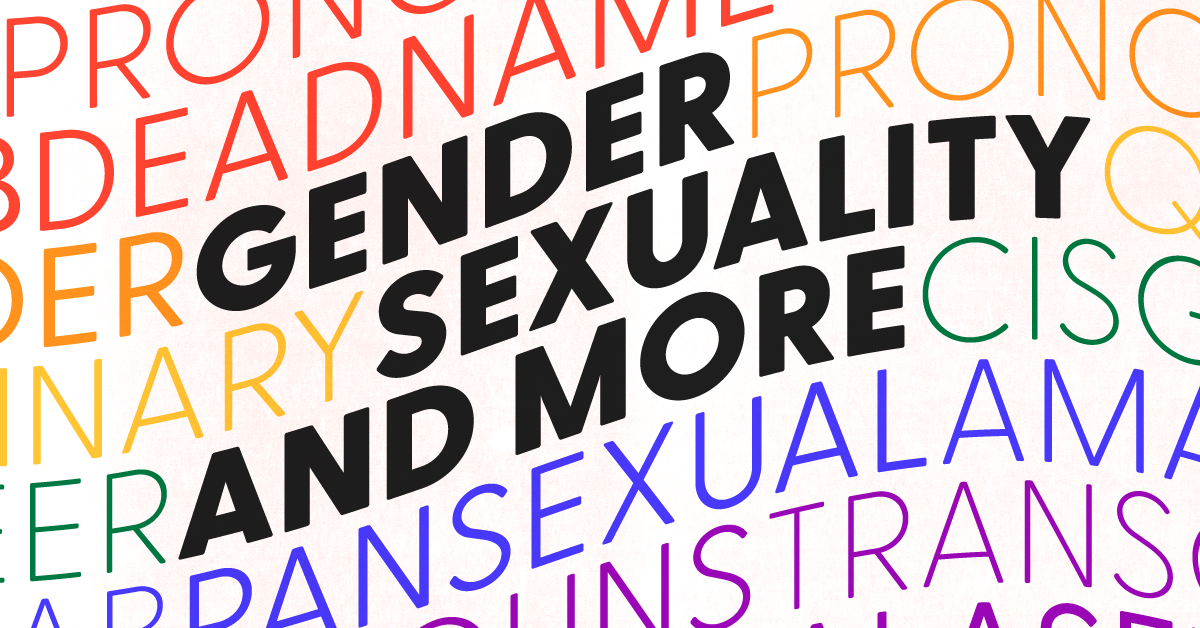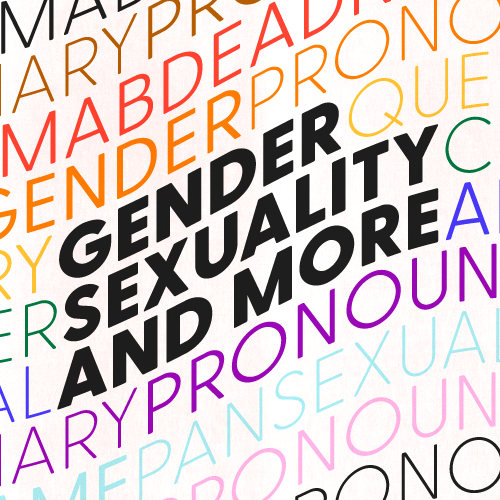
What is pansexual? What about “cisgender”? No matter what your answer is, odds are your child is familiar with them. In a recent study, less than half of the polled members of Generation Z identified as “completely heterosexual” — the rest fell somewhere along a spectrum. This demonstrates the expansive view this generation takes toward sexual orientation, gender identity, and more. Gen Zers are also more likely to say they personally know someone who goes by gender-neutral pronouns like “they.” As one young woman stated in a recent New York Times article, “[Our generation] has the tools and language to understand identity in ways our parents never really thought about.”
If you came of age in the ’90s, you may be a little confused. Many folks can understand the difference between being gay and straight, but today there are multiple ways to identify and express one’s self. The differences aren’t as confusing as they might seem at first, however. All it takes is a little time and effort to understand these words and what they mean. In this post, we break down the general concepts and definitions you need to better understand how teens today discuss their relationships to gender, sexuality, and more with terms such as pansexual and cisgender.
Understanding Sex, Gender, and Sexual Orientation
People used to think of sex, gender, and sexual orientation in very simple terms, but now we understand it to be much more dynamic. For example, just because someone is biologically male or female, it doesn’t mean that they have to build their gender identity around those terms. People are also free to express their identity however they choose, and they can be romantically or sexually attracted to a wide range of genders along a spectrum. The following definitions can help you understand the differences in greater detail.
Sex is assigned at birth and refers to one’s biological status. It’s associated primarily with physical attributes like chromosomes, hormone prevalence, and external and internal anatomy.
Gender, on the other hand, refers to the socially constructed expectations around behaviors, activities, and forms of expression that others consider appropriate for people of a particular sex. Words used to describe one’s gender can include male, female, man, woman, nonbinary, queer, genderqueer, genderfluid, and more.
Sexual orientation refers to the emotional, romantic, and/or sexual attraction between human beings. It is independent of one’s sex and gender, and it can encompass many different identities — heterosexual, homosexual, bisexual, asexual, and pansexual are common orientations that we’ll discuss in greater detail below.
A Quick Guide to Common Terms
We’ve collected some of the most commonly used terms surrounding the topics of gender, sex, and sexual orientation today. You’ll also see many used in context, such as pansexual, with helpful examples to help you better understand them.
AFAB/AMAB
This acronym is short for “assigned female at birth” or “assigned male at birth.” It’s often used when someone wants to describe the gender identity they were given as a child, often in contrast to their present gender identity.
Example: I was AFAB, but I identify as a transman.
Asexual
Asexual is an umbrella term for individuals who experience zero or low levels of sexual attraction and desire. They may, however, have an interest in romantic, emotional, or intimate relationships. A commonly used slang term for an asexual person is “ace.”
Bisexual
While bisexuality was traditionally used to denote attraction to both men and women, the term now encompasses being romantically and/or sexually attracted to more than one gender. It is often mistakenly conflated with being pansexual (see below). Bisexuality is also commonly abbreviated as “bi.”
Cisgender
The term “cisgender” is used when a person’s gender identity corresponds with their birth sex. It contrasts with “transgender,” which is used when someone’s gender identity does not match their birth sex (see below). “Cisgender” is commonly abbreviated as “cis.”
Example: Joe, who was AMAB, is cisgender because he identifies as a man. Shauna, who was AMAB, identifies as a woman.
Deadname
Sometimes people are given birth names that end up being misaligned with their gender identity. When a person transitions to the gender they understand themselves to be, that name becomes their “deadname.” For example, someone assigned male at birth might be given the name Scott, but if they come to understand that they actually identify as a woman (she/her). As part of her transition, she will change her name to something better suited to her identity, retiring the deadname in the process. People should no longer reference her deadname unless given clear permission to do so.
When used as a verb, “deadnaming” occurs when someone (whether intentionally or not) calls a trans person the name they used before they transitioned. You may also hear it described as referring to someone by their “birth name” or their “given name.” Some people refuse to use a trans person’s chosen name as a way to reject and shame them.
Gender expression
This phrase encompasses a person’s outward presentation of their gender identity, as expressed through behavior and external characteristics such as clothing, hairstyle, and more.
Gender identity
The internal, personal sense of one's own gender. Gender identity can be the same as a person’s assigned sex at birth or can differ from it. It’s not necessarily apparent what someone’s gender identity is based on their gender expression, which is why many people have begun including their pronouns in Twitter bios, email signatures, and more. If you are ever unsure of how to refer to someone, you can ask them what pronouns they would like you to use.
Example: Even though Kenzie was AFAB, his gender identity is male.
Intersex
Intersex is an umbrella term used for a variety of conditions in which a person is born with a reproductive or sexual anatomy that doesn’t match the typical definitions of female or male.
Example: An intersex person may have both testes and ovaries.
Nonbinary
According to GLAAD, to be nonbinary is to “identify yourself, and your gender, as existing outside of the binary definitions of man or woman, masculine or feminine.” Many nonbinary individuals use the pronouns they/them/theirs. Nonbinary people may be referred to as “NB’s,” which can also be pronounced phonetically: “en-bee.”
Example: “Did you meet the new boy in homeroom?”
“Oh, their name is Ollie and they’re actually NB.”
“I didn’t know! Thanks for telling me.”
Pansexual
What is pansexual? Pansexual means being romantically and/or sexually attracted to people regardless of their gender — including transgender and gender-nonconforming people. The prefix “pan” means “all” in Greek. Some pansexual individuals use the slang term “pan” when referring to their own sexuality, as in, “Oh, I’m not gay — I’m pan.”
Pronouns
Because of the expansive nature of gender identity and expression, a person may not identify with traditional pronoun assignment (she/her/hers or he/him/his). A nonbinary person may use the pronouns “they/them/theirs,” or they may ask that you use other pronouns. Some people say they feel comfortable being referred to with a combination of two types of pronouns (like feminine and gender neutral), and some people even feel comfortable with all pronouns.
Example: “Did you happen to see where Jin left their history book?
“I did! I grabbed it and will give it to them in 3rd period.”
Similarly, a transperson may use pronouns that are different from the ones they were assigned as a child. You might not always not be aware of a person’s gender, so it’s important not to make assumptions about which pronouns you think they’d prefer. Respecting a person’s choice pronouns is integral to promoting acceptance and inclusion for gender-nonconforming and trans people. If you’re confused, simply ask what pronouns they’d like for you to use when referring to them.
Queer
“Queer” is an umbrella term to describe someone who does not identify as straight and/or cisgender. Many people decide to identify as queer in place of (or in addition to) more established identities such as gay, lesbian, or bisexual. It enables an individual to identify with the broader LGBTQ+ community without having to say exactly how. In this sense, “queer” conveys both an all-purpose orientation and a sense of belonging.
Transgender (“trans”)
Transgender is an umbrella term for people whose gender identity and/or gender expression does not conform to that typically associated with the sex they were assigned at birth (see AFAM/AMAB). Whether a transperson has physically transitioned (with hormones or gender confirmation surgery) is irrelevant to their gender identity.
We hope this guide has answered the question of "what is pansexual" and has given you a little extra clarity around questions related to some of the more recent terms people use to talk about human sexuality and gender identity. Today’s society may look a little different from the one we grew up in (electric cars, the ability to pause TV, spray-on sunscreen), but so did the society of our parents. Every generation encounters developments in technology and social progress that seem overwhelming and complicated at first, but once we understand them, we accept them as just another normal part of our lives. New perspectives for talking about concepts like gender, pansexual sexual orientation, and identity are among these developments. At the end of the day, though, it’s important to support your child no matter how they identify or who they love.
Two-Spirit
This is a Native American term for male, female, and sometimes intersex individuals who combined activities of both men and women.
Example: "Two-Spirit people represent a gender that's outside the traditional male/female binary."
Additional Resources
For more information related to LGBTQ+ issues and further information regarding pansexual, queer, and trans terminology:
- A Guide to Being an Ally to Transgender and Nonbinary Youth
- PFLAG (Parents and Friends of Lesbians and Gays)
- National Queer and Trans Therapists of Color Network
- Human Rights Campaign parenting blog
- What is Pansexual? A Guide to Pansexuality
- Transgender Children & Youth: Understanding the Basics
- Parenting in a Tech World
If your child needs help:
- LGBT National Youth Talkline
- Trans Lifeline: 877-565-8860
- TrevorText: Text START to 678-678
Read more
Bark helps families manage and protect their children’s digital lives.





